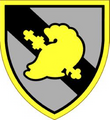Category:Heraldry of the United States Military Academy
Shoulder Sleeve Insignia
editDescription
edit- On a gray shield, 2 5/8 inches (6.67 cm) in width and 2 7/8 inches (7.30 cm) in height, with a 1/8 inch (.32 cm) golden yellow edging outside a 1/16 inch (.16 cm) black border, and a 3/4 inch (1.91 cm) black bend (dexter), the helmet of Pallas over a Greek sword, both golden yellow edged in black.
- Combat Service Identification Badge: None Authorized.
Background
edit- The shoulder sleeve insignia was originally approved on 1941-11-26.
- It was amended on 1957-03-22.
Distinctive Unit Insignia
editDescription
edit- Azure, upon a Greek sword, in scabbard bendwise, the helmet of Pallas Or. A shield of flag blue displaying the device of the Military Academy in gold.
Background
edit- The Distinctive Unit Insignia was originally approved for the U.S. Military Academy Detachment of Troops on 1923-04-23.
- The insignia was redesignated on Oct 1970 for wear by the Staff and Faculty, U. S. Military Academy.
Coat Of Arms
editBlazon
edit- Shield: On a shield of the United States of America the emblem of the United States Military Academy, viz; a helmet of Pallas over a Greek sword, Proper.
- Crest: An eagle with wings displayed.
- Motto: “Duty, Honor, Country,” borne on a scroll with the words “West Point, MDCCCII, U.S.M.A.”
Symbolism
edit- The emblem consists of the helmet of Pallas Athene, which has for centuries been the symbol of wisdom and learning, over a Greek sword, the symbol of the military profession. The two together typify the military and educational functions of the Academy.
Background
edit- The coat of arms of the United States Military Academy was approved by the Secretary of War on 1898-10-08.
- Sometime prior to 1898, a board consisting of the then Professors Larned, Bass, and Tillman, were appointed to design a coat of arms that could be used on diplomas, invitations, publications, insignia, Corps flags, buttons and other similar purposes as well as for sculptured decorations of the public buildings at the Academy.
- Before arriving at a final decision, the committee had prepared many tentative designs, original sketches of which are preserved in the Drawing Academy.
- The Committee also consulted with Dr. Holden, Librarian of the Military Academy and author of a book on Heraldry, and incorporated in its final design, suggestions received from certain well known artists including Mr. Stanford White, and calculated to improve the proportions, balance and general artistic beauty.
- In 1922, when the War Department was having Coats of Arms made up for the various regiments in the service, the Superintendent submitted the design for the coat of arms.
- After studying the designs and comparing them with certain books of Heraldry, Captain George M. Chandler, then on duty with the General Staff, in a letter to Brigadier General F.W. Sladen, then Superintendent, called attention to the fact that the eagle, the helmet of Pallas Athene and the Greek sword faced to the sinister (the left hand side of the shield from the standpoint of the man behind it) instead of dexter (the right hand side of the shield from the standpoint of the man behind it), which was contrary to the best heraldic usage.
- After having the subject carefully investigated, the Superintendent wrote to the Adjutant General of the Army, recommending the helmet, sword and head of the eagle be turned to dexter.
- These recommendations were approved, and on 1923-07-02, the Coat of Arms for the United States Military Academy, which is now in use, was drawn and approved by the Quartermaster General.
Media in category "Heraldry of the United States Military Academy"
The following 6 files are in this category, out of 6 total.
-
ALNG Logo New.png 2,250 × 2,291; 597 KB
-
U.S. Military Academy COA.png 673 × 589; 559 KB
-
United States Military Academy Coat of Arms.svg 765 × 990; 282 KB
-
USAMA DUI.png 916 × 1,120; 120 KB
-
USMA SSI.png 1,037 × 1,133; 123 KB
-
West Point coat of arms.jpg 681 × 599; 120 KB





